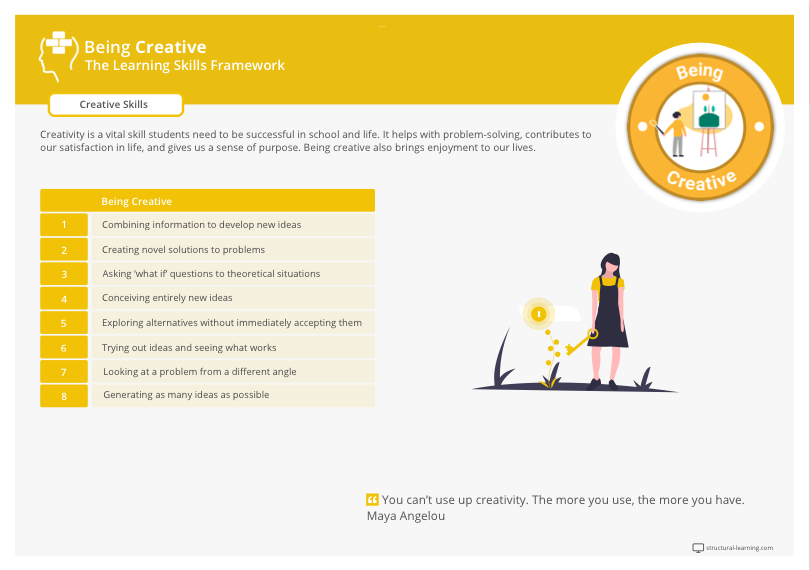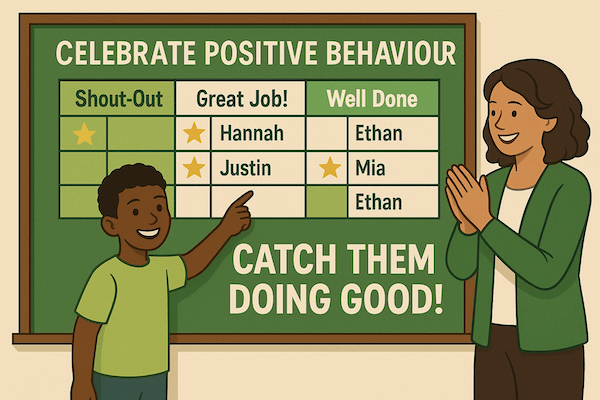Getting Started with Strategies for Behaviour Management
A teacher's guide to classroom behaviour management strategies. Research and practice to make sure everyone is learning.


A teacher's guide to classroom behaviour management strategies. Research and practice to make sure everyone is learning.
Behaviour management is a way to modify behaviour that concentrates on maintaining order. Its main focus is on discouraging negative behaviour while shaping and upholding positive behaviours using less severe strategies than those used in structured behaviour modification.
An effective behaviour management strategy has a major impact on a classroom. A teacher can create an incredible lesson, but if there is no proper behaviour management in the classroom, students will remain unable to fully participate in the lesson.
Finding safe and effective behaviour management strategies that empower both teachers and students play a crucial role in maintaining a positive learning environment. Behaviour Management is not all about penalizing unwanted behaviour or even rewarding positive behaviour. Rather it is related to having strategies in place to help children to act in ways that help them learn the most from their lesson. Depending on the type of institution, behaviour management in schools is always a top priority. Without a school-wide policy that everyone adheres to and a consistent set of effective behaviour management strategies, classrooms can quickly become disruptive places.
In this article we will try to identify some of the approaches to classroom management that will immediately have an impact. You probably do not need a behaviour management Guru, abiding by some simple principles can very quickly change the culture of a school. This article will focus on positive behaviour management techniques rather than developing a regime of harsh punishments. For many experienced teachers, the contents of this article might be second nature. However, if you are an NQT or just want to brush up on your skills and we think you'll find some classroom behaviour management ideas.
Below is a list of some of the most effective classroom management strategies teachers can use to become even more effective teachers.

As an effective classroom behaviour management strategy, the teachers must demonstrate the behaviour they want to see in their students. Effective modelling prepares students for acting in different conditions.
An easy way to model specific behaviour is to arrange a discussion with an administrator, other educators or senior class in front of the students. While talking about anything teachers can make sure to:
Subsequently, it is recommended to initiate a class discussion to talk about and enhance the ideal behaviours demonstrated by both parties. Remember that everyone makes mistakes and that respect is reciprocal. So, teachers must admit if they make a mistake and they must show respect to students such that they can be respected in return.

Promoting compatible and value-based rules can create a positive learning environment in which each student has the opportunity to learn and succeed.
To build a positive learning environment, teachers and students must collaborate while creating the class rules.
These rules must express how students should interact with one another, with the teachers, and with the physical space around them. This will hopefully reduce the chances of encountering confrontational situations as everyone will know what the rules are. If there are disruptive pupils in your class then involving them in this process will give them an opportunity for positive reinforcement. When students take part in creating the rules that will manage their class, they get a feeling of ownership for their class. Following are the rules that teachers can use in their classroom:
Teachers can remind students that class rules are in place to guide their learning. Classroom rules must be displayed innovatively and engagingly to get the creativity flowing in the classroom.

Teachers must set a clear routine for the things they want their students to do in the classroom. They may find it tedious, but it is important to make a routine and show students that the teachers want students to do everything correctly. It is not right to assume that students already know how do their teachers want things to be done. Teachers can provide students with many opportunities to apply the classroom routines. They can provide ongoing support for certain behaviours and routines; reinforce desired behaviours and clarify the outcomes if the expectations are not fulfilled.
Students mostly get in trouble because sometimes they genuinely don't know how they are expected to perform. Once teachers are certain that their students know what is expected from them in all areas of the classroom, it becomes a lot easier to administer consequences for demonstrating any specific behaviour in the classroom.
Below are some routines to establish in the classroom :
If teachers talk positively about those students who follow classroom routines, it motivates others to do the same. It is suggested that the teachers must give positive feedback for showing good gestures right away. This will not only encourage them to continue to show positive behaviour, but it will also motivate those who may haven't heard the first time.

Rewarding positive behaviour is one of the most important behaviour management strategies. Rewards can be solitary, team or class-based. Like students participate in designing class rules, they must contribute to the rewards. This will encourage students to work to achieve the rewards they truly want. Teachers must use a reward system that can be easily managed. Consider rewards that do not require excessive preparation or a huge financial investment for any individual.
Since corrections must be polite, praise needs to happen frequently and publicly. Many teachers use “Shout-outs” to highlight positive behaviour in the class. Praise must acknowledge the specific behaviour student is executing correctly. Students must be praised in front of their classmates, teachers, and administrators. Their positive behaviour must be discussed enthusiastically, students love to see acknowledgement for something they have done well. Classrooms often use a rewards chart to reinforce positive behaviour. If your school is interested in developing learning behaviours then you might want to have a look at the Learning Skills framework. Our reward system goes beyond the traditional behaviour chart and highlights the learning behaviours associated with academic success.
Building a profound relationship with the students shows that the teacher cares for them and is instilled in their well being. At the beginning of the year, get-to-know-you activities and surveys are great to create a bonding with students. When students feel that their teacher is invested in them, they develop respect. This respect plays an important role in making a student accountable for his behaviour. Some of the most effective ways to build a strong relationship include:

It is suggested that the teachers must stay calm while administering corrections. It is always better to address individual discipline problems in isolation rather than penalizing the whole class, as the latter can harm a teacher's relationship with the whole class.
When dealing with disruptive students, it is recommended that the classroom teacher does their best to remain relaxed but assertive but never raise their voice. This helps to prevent further disruption and ensures that the student understands the consequences of their actions.
Disruptive behaviour often takes school leaders away from other pressing tasks. The behavioural expectations of students need to be documented within the school policy and communicated using clear visuals around the school. These ground rules can set the benchmark for addressing problematic behaviours before they start impacting learning outcomes.
As well as having a clear set of strategies for behaviour management, school environments can do a lot for promoting cultures of positive relationships.
Any behavioural consequence must not hurt any individual's emotions, rather it must be a response to the clearly defined class rule or class routine. It is suggested to avoid language like, “If you do..…then I will… .” Teachers must explain consequences firmly, as they are outlined in the class. They must consistently tell consequences to each student every time anyone is failed in meeting expectations. Students are quick to notice if a teacher does not always give a consequence or if the teacher gives consequences to any particular student more often than others.
After the above discussion, it can be said that establishing some ground rules is a necessity for effective classroom management. These strategies are not only helpful for teachers and students to move forward in a well planned and logical way but also helps in building effective classroom discipline. Classroom management strategies are in fact, a set of rules that play an important role in developing a structure for school classroom functions and for organizing learning activities. But, the teachers must demonstrate consistency while developing and implementing classroom rules just to prevent confusion in students. Also, they must lead from the front by modelling certain behaviours they expect to see in the students.

1. What are some of the common classroom management techniques?
2. How should we deal with disruptive behavior?
3. Why is it necessary to establish clear guidelines before starting teaching?
4. Can you suggest other methods which may help us improve our classroom environment?
5. Are there any specific tools/techniques used in classrooms today?
6. Is it possible to teach children without using punishment?
7. Do you think that all schools should have a zero tolerance policy towards disruption?
8. Should parents be involved in disciplining their child at school? If yes, how?

Behaviour management is a way to modify behaviour that concentrates on maintaining order. Its main focus is on discouraging negative behaviour while shaping and upholding positive behaviours using less severe strategies than those used in structured behaviour modification.
An effective behaviour management strategy has a major impact on a classroom. A teacher can create an incredible lesson, but if there is no proper behaviour management in the classroom, students will remain unable to fully participate in the lesson.
Finding safe and effective behaviour management strategies that empower both teachers and students play a crucial role in maintaining a positive learning environment. Behaviour Management is not all about penalizing unwanted behaviour or even rewarding positive behaviour. Rather it is related to having strategies in place to help children to act in ways that help them learn the most from their lesson. Depending on the type of institution, behaviour management in schools is always a top priority. Without a school-wide policy that everyone adheres to and a consistent set of effective behaviour management strategies, classrooms can quickly become disruptive places.
In this article we will try to identify some of the approaches to classroom management that will immediately have an impact. You probably do not need a behaviour management Guru, abiding by some simple principles can very quickly change the culture of a school. This article will focus on positive behaviour management techniques rather than developing a regime of harsh punishments. For many experienced teachers, the contents of this article might be second nature. However, if you are an NQT or just want to brush up on your skills and we think you'll find some classroom behaviour management ideas.
Below is a list of some of the most effective classroom management strategies teachers can use to become even more effective teachers.

As an effective classroom behaviour management strategy, the teachers must demonstrate the behaviour they want to see in their students. Effective modelling prepares students for acting in different conditions.
An easy way to model specific behaviour is to arrange a discussion with an administrator, other educators or senior class in front of the students. While talking about anything teachers can make sure to:
Subsequently, it is recommended to initiate a class discussion to talk about and enhance the ideal behaviours demonstrated by both parties. Remember that everyone makes mistakes and that respect is reciprocal. So, teachers must admit if they make a mistake and they must show respect to students such that they can be respected in return.

Promoting compatible and value-based rules can create a positive learning environment in which each student has the opportunity to learn and succeed.
To build a positive learning environment, teachers and students must collaborate while creating the class rules.
These rules must express how students should interact with one another, with the teachers, and with the physical space around them. This will hopefully reduce the chances of encountering confrontational situations as everyone will know what the rules are. If there are disruptive pupils in your class then involving them in this process will give them an opportunity for positive reinforcement. When students take part in creating the rules that will manage their class, they get a feeling of ownership for their class. Following are the rules that teachers can use in their classroom:
Teachers can remind students that class rules are in place to guide their learning. Classroom rules must be displayed innovatively and engagingly to get the creativity flowing in the classroom.

Teachers must set a clear routine for the things they want their students to do in the classroom. They may find it tedious, but it is important to make a routine and show students that the teachers want students to do everything correctly. It is not right to assume that students already know how do their teachers want things to be done. Teachers can provide students with many opportunities to apply the classroom routines. They can provide ongoing support for certain behaviours and routines; reinforce desired behaviours and clarify the outcomes if the expectations are not fulfilled.
Students mostly get in trouble because sometimes they genuinely don't know how they are expected to perform. Once teachers are certain that their students know what is expected from them in all areas of the classroom, it becomes a lot easier to administer consequences for demonstrating any specific behaviour in the classroom.
Below are some routines to establish in the classroom :
If teachers talk positively about those students who follow classroom routines, it motivates others to do the same. It is suggested that the teachers must give positive feedback for showing good gestures right away. This will not only encourage them to continue to show positive behaviour, but it will also motivate those who may haven't heard the first time.

Rewarding positive behaviour is one of the most important behaviour management strategies. Rewards can be solitary, team or class-based. Like students participate in designing class rules, they must contribute to the rewards. This will encourage students to work to achieve the rewards they truly want. Teachers must use a reward system that can be easily managed. Consider rewards that do not require excessive preparation or a huge financial investment for any individual.
Since corrections must be polite, praise needs to happen frequently and publicly. Many teachers use “Shout-outs” to highlight positive behaviour in the class. Praise must acknowledge the specific behaviour student is executing correctly. Students must be praised in front of their classmates, teachers, and administrators. Their positive behaviour must be discussed enthusiastically, students love to see acknowledgement for something they have done well. Classrooms often use a rewards chart to reinforce positive behaviour. If your school is interested in developing learning behaviours then you might want to have a look at the Learning Skills framework. Our reward system goes beyond the traditional behaviour chart and highlights the learning behaviours associated with academic success.
Building a profound relationship with the students shows that the teacher cares for them and is instilled in their well being. At the beginning of the year, get-to-know-you activities and surveys are great to create a bonding with students. When students feel that their teacher is invested in them, they develop respect. This respect plays an important role in making a student accountable for his behaviour. Some of the most effective ways to build a strong relationship include:

It is suggested that the teachers must stay calm while administering corrections. It is always better to address individual discipline problems in isolation rather than penalizing the whole class, as the latter can harm a teacher's relationship with the whole class.
When dealing with disruptive students, it is recommended that the classroom teacher does their best to remain relaxed but assertive but never raise their voice. This helps to prevent further disruption and ensures that the student understands the consequences of their actions.
Disruptive behaviour often takes school leaders away from other pressing tasks. The behavioural expectations of students need to be documented within the school policy and communicated using clear visuals around the school. These ground rules can set the benchmark for addressing problematic behaviours before they start impacting learning outcomes.
As well as having a clear set of strategies for behaviour management, school environments can do a lot for promoting cultures of positive relationships.
Any behavioural consequence must not hurt any individual's emotions, rather it must be a response to the clearly defined class rule or class routine. It is suggested to avoid language like, “If you do..…then I will… .” Teachers must explain consequences firmly, as they are outlined in the class. They must consistently tell consequences to each student every time anyone is failed in meeting expectations. Students are quick to notice if a teacher does not always give a consequence or if the teacher gives consequences to any particular student more often than others.
After the above discussion, it can be said that establishing some ground rules is a necessity for effective classroom management. These strategies are not only helpful for teachers and students to move forward in a well planned and logical way but also helps in building effective classroom discipline. Classroom management strategies are in fact, a set of rules that play an important role in developing a structure for school classroom functions and for organizing learning activities. But, the teachers must demonstrate consistency while developing and implementing classroom rules just to prevent confusion in students. Also, they must lead from the front by modelling certain behaviours they expect to see in the students.

1. What are some of the common classroom management techniques?
2. How should we deal with disruptive behavior?
3. Why is it necessary to establish clear guidelines before starting teaching?
4. Can you suggest other methods which may help us improve our classroom environment?
5. Are there any specific tools/techniques used in classrooms today?
6. Is it possible to teach children without using punishment?
7. Do you think that all schools should have a zero tolerance policy towards disruption?
8. Should parents be involved in disciplining their child at school? If yes, how?
